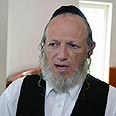
Years ago, he was active in an organization called Keshet, which fought against autopsies and archaeological digs in gravesites. Its activities included desecrating monuments and stores in Jerusalem, spraying graffiti on Theodor Herzl's grave and calls for murder.
In his book, "The Underground Youth," Meshi-Zahav reveals the group's methods. As part of the book launch, he releases different chapters to the haredi press from time to time.
In one of the chapters, Meshi-Zahav describes how the group members scrawled graffiti on road signs on the Jerusalem-Tel Aviv Highway with the caption, "Driver, beware – the pathologist is hungry."
The activists dressed up as Public Works Department employees and destroyed the signs in protest of autopsies.
According to the book, once they discovered that their actions had no effect, "we decided to bring hell into their homes." They poured tar at the entrance to the houses of doctors and pathologists and planted fake explosives.
These actions were committed with the help of a young haredi man who dressed up as a disabled person and followed the pathologists to their homes, Meshi-Zahav reveals.
In other cases, the activists gave children letters containing bullets and sent them to the doctors. The message inside the letters informed the doctors that "this time it's only in the mail."
Later, disguised as plumbers, the underground members tampered with the drinking water of additional "enemies" – activists supporting archaeological digs in gravesites, pouring sticky paint into the water.
"In some of the archaeologists' water we put Ex Lax Chocolate, which immediately causes diarrhea," Meshi-Zahav writes.
The ZAKA chairman clarifies that despite writing a book, he has no plans to retire from public life.
"I am not one of those people who write and cover what happens from the side, but one of those who do things and document them for the generations to come," he says.















